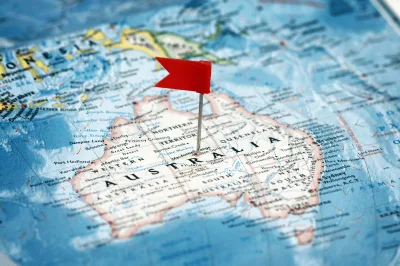On This Page...
ToggleDe Facto Visa Australia: Complete Guide for Couples
By Nilesh Nandan – Australian Immigration Lawyer, MyVisa® Immigration Lawyers
This blog is intended for discussion purposes only and does not constitute advice. You should seek independent legal advice before relying on any information provided on this site.
Immigration policies, systems, and processes can change without notice. I’d like to know your own experience with the immigration challenges noted above — feel free to contact me.
Table of Contents
Introduction
As an immigration lawyer, I meet hundreds of couples each year who are confused about what a “de facto visa” actually is. Many think it’s a separate visa subclass – it isn’t. Rather, “de facto” refers to your relationship type when applying for a Partner Visa in Australia.
If you are in a genuine, committed relationship but not legally married, you may be eligible for a de facto visa under either the onshore (Subclass 820/801) or offshore (Subclass 309/100) Partner Visa pathways. The law recognises your relationship if you can show that you and your partner have lived together for at least 12 months (or less, if registered under State law).
This guide explains everything — from proving your relationship, meeting eligibility, comparing onshore and offshore options, to avoiding costly mistakes that lead to refusals. Whether you’re already in Australia or applying from overseas, my goal is to help you understand exactly what to do and how to do it right the first time.
Understanding the De Facto Visa
The term “de facto visa” is commonly used but technically refers to the Partner Visa subclasses that apply to unmarried couples. Your relationship must meet the Migration Regulations 1994 definition of “de facto partner,” meaning you are not legally married, but have a genuine and continuing relationship and live together (or do not live apart permanently).
What the De Facto Visa Allows You to Do
- Live, work, and study in Australia while awaiting your visa outcome.
- Access Medicare (once the temporary stage visa is granted).
- Travel in and out of Australia freely once on the visa.
- Progress to permanent residence through the second stage of the Partner Visa.
Essentially, this visa recognises and protects genuine relationships that are not yet formalised by marriage, ensuring both partners can live together in Australia lawfully. ([immi.homeaffairs.gov.au](https://immi.homeaffairs.gov.au/visas/getting-a-visa/partner-onshore))
Eligibility Criteria for De Facto Partner Visa
To qualify for a de facto partner visa, you must demonstrate a relationship that satisfies strict legal requirements. These are set out under Regulation 1.09A of the Migration Regulations 1994.
Basic Eligibility Requirements
- You and your partner must be aged 18 or older.
- You must be in a genuine and continuing relationship to the exclusion of all others.
- You must live together or not live apart permanently.
- You must show that the relationship has existed for at least 12 months prior to application unless registered under state/territory law (e.g., NSW Relationship Register).
- Your partner must be an Australian citizen, permanent resident, or eligible New Zealand citizen.
Character and Health
Both partners must meet health and character requirements. This may include police checks from every country lived in for 12+ months and health examinations approved by Home Affairs.
Special Circumstances
There are exemptions to the 12-month rule. For example:
- If your relationship is registered under Australian State or Territory law.
- If compelling circumstances exist (e.g., children of the relationship, humanitarian protection).
- If you could not live together due to workplace, cultural, or visa restrictions but maintained evidence of commitment.
Proof of Relationship – The Core of Your Application
The single biggest reason partner visa applications fail is insufficient or inconsistent relationship evidence. Home Affairs assesses your relationship across four key factors:
- Financial aspects of the relationship
- Nature of the household
- Social aspects of the relationship
- Nature of your commitment to each other
Examples of Acceptable Evidence
| Category | Examples of Evidence |
|---|---|
| Financial | Joint bank accounts, shared bills, joint property lease or mortgage, tax declarations as partners. |
| Household | Shared rental agreements, joint utilities, correspondence to same address, photos of daily life. |
| Social | Photos together at family or social events, invitations addressed to both, statutory declarations from friends/family. |
| Commitment | Long-term plans, wills, superannuation beneficiaries, communication records showing emotional support. |
To strengthen your case, present your evidence in chronological order and include personal statements detailing how your relationship developed. The most convincing applications tell a consistent story supported by documentation.
Onshore vs Offshore De Facto Visa (820/801 vs 309/100)
You can apply for the partner visa as a de facto partner either while you are in Australia (onshore) or from outside the country (offshore). The two streams are structurally similar but differ in timing, processing, and conditions.
| Feature | Onshore (Subclass 820/801) | Offshore (Subclass 309/100) |
|---|---|---|
| Where You Apply | In Australia | Outside Australia |
| Temporary Stage | Subclass 820 (apply and stay in Australia while processing) | Subclass 309 (apply from overseas, may enter once granted) |
| Permanent Stage | Subclass 801 (usually assessed two years after 820) | Subclass 100 (assessed after 309) |
| Work Rights | Full work and study rights after 820 grant | Full work rights after 309 grant |
| Medicare | Eligible after 820 grant | Eligible once in Australia after 309 |
| Processing Time | 16–28 months on average | 15–29 months on average |
| Cost (as of 2025) | From AUD 8,850 | From AUD 8,850 |
| Advantages | Allows you to remain in Australia while waiting | Ideal if you cannot enter Australia yet |
| Disadvantages | Bridging visa delays if previous visa expires | No bridging visa protection before arrival |
For most couples already together in Australia, the onshore route offers convenience and security. However, offshore applications may suit those separated by border, work, or timing constraints.
Step-by-Step Application Process
The de facto partner visa involves two stages — temporary and permanent. You lodge one combined application and pay one fee.
- Confirm eligibility – ensure your relationship meets de facto criteria and that your partner is an eligible sponsor.
- Gather evidence – compile all documents proving your relationship across the four categories mentioned above.
- Create an ImmiAccount – all partner visa applications are lodged online.
- Complete the Partner Visa Application Form – provide accurate details about both partners.
- Your partner lodges the Sponsorship Form (Form 40SP) – this must be done soon after your main application.
- Upload documents – certified copies of passports, evidence, and statutory declarations (Form 888 from witnesses).
- Pay the visa fee – AUD 8,850 (as at 2025), payable once for both stages.
- Receive Bridging Visa (onshore only) – if your current visa expires while awaiting decision.
- Attend health and character checks – police clearances and medical exams.
- Wait for decision – first the temporary stage (820/309), then after ~2 years, the permanent stage (801/100).
For complex cases — e.g., previous visa cancellations or criminal records — seek professional assistance. I’ve represented clients who faced visa cancellations and visa refusals but succeeded on appeal by providing stronger, better-organised evidence.
Processing Time, Cost & Timeline
Cost
- Visa application charge: AUD 8,850 (main applicant).
- Additional applicant (18+): AUD 4,430.
- Additional applicant (under 18): AUD 2,215.
Processing Time (as at October 2025)
- 75% of applications: 16–28 months for Subclass 820.
- 90% of applications: up to 32 months for Subclass 801/100.
Timeline Overview
| Stage | Description | Average Duration |
|---|---|---|
| Preparation | Gathering documents, drafting forms | 1–3 months |
| Application lodgement | Online submission via ImmiAccount | Immediate |
| Bridging Visa (if onshore) | Activates after current visa expires | Varies |
| Temporary Visa Grant | Subclass 820/309 issued | 16–28 months |
| Permanent Visa Stage | Subclass 801/100 assessment | ~24 months after temporary stage |
Common Reasons for De Facto Visa Refusals
Visa refusals often happen not because the relationship is fake, but because the evidence fails to meet legal standards. Common reasons include:
- Insufficient evidence across one or more of the four relationship categories.
- Contradictions in personal statements and witness declarations.
- Failure to meet the 12-month cohabitation requirement or prove exemption.
- Incorrect or outdated statutory declarations (Form 888).
- Inconsistent address or travel records between partners.
- Not disclosing previous visa refusals or cancellations.
- Not providing certified translations for non-English documents.
If your application has been refused, it may still be reviewable at the Administrative Appeals Tribunal (AAT). My team frequently helps clients file successful appeals by fixing the evidence gaps that led to the initial refusal.
Real-Life Scenarios & Legal Insights
Case 1 – Student and Australian Citizen
Maria, an international student from Brazil, began living with her Australian partner while finishing her degree. They applied for the onshore de facto visa before her student visa expired. By showing joint bank accounts, shared lease, and social evidence, her 820 was granted within 20 months. She later obtained permanent residency under subclass 801.
Case 2 – Couple Living Apart Due to Work
Sanjay worked in Perth while his partner Priya was posted interstate. They saw each other monthly and maintained a joint bank account. Though living separately, they documented constant communication and registered their relationship in NSW, meeting exemption requirements. Their offshore application was approved after 24 months.
Case 3 – Visa Refusal Overturned
A de facto visa for a same-sex couple was initially refused due to inconsistent timelines in their statements. Upon appeal, we demonstrated the relationship history with additional witness declarations, digital communication logs, and statutory declarations correcting the errors. The AAT set aside the refusal and the visa was granted.
Evidence & Document Checklist
Before submitting your application, ensure you have the following:
- Identity documents (passports, birth certificates, photos).
- Relationship evidence: financial, household, social, and commitment proof.
- Police clearances for both partners.
- Health check results (authorised panel physician).
- Form 888 declarations from two or more Australian citizens or PRs.
- Proof of sponsor’s citizenship or PR status.
- Relationship registration certificate (if applicable).
- Translations of non-English documents.
- Cover letter summarising relationship and evidence.
Frequently Asked Questions
- How long does it take to get a de facto visa in Australia?
Processing times vary, but most onshore applications take 16–28 months for the temporary stage, and permanent stage follows about two years later.
- How much does the de facto visa cost?
The visa charge starts from AUD 8,850 for the main applicant, plus additional charges for family members.
- What happens if my relationship ends before the permanent stage?
Your visa may be cancelled unless there are special circumstances such as domestic violence or a child of the relationship.
- Can my de facto visa be refused under Section 501 (character grounds)?
Yes. If you fail the character test under Section 501 of the Migration Act 1958, your visa can be refused or cancelled. Seek legal representation immediately.
- Can I apply if we have not lived together for 12 months?
Yes, if your relationship is registered in an Australian state or there are compelling circumstances like having a child together.
- Do I need to be onshore for the permanent stage?
- Yes, for subclass 801, you must be in Australia at the time of decision; for 100, offshore at the time of decision.
Book a Consultation
The de facto visa process can feel overwhelming — but with the right guidance, it doesn’t have to be. I’ve helped thousands of couples navigate this complex area of law successfully, even after refusals or cancellations.
Book a consultation with me today to discuss your visa situation.
For further resources, visit Visa Refusals, Visa Cancellations, Partner Visas, and Contact MyVisa to arrange your consultation.
Legal Disclaimer
By Nilesh Nandan — Australian Immigration Lawyer, MyVisa®️ Immigration Lawyers
This blog is intended for discussion purposes only and does not constitute advice. You should seek independent legal advice before relying on any information provided on this site. Immigration policies, systems, and processes can change without notice. I’d like to know your own experience with the immigration challenges noted above — feel free to contact me.
MyVisa: Nilesh Nandan, Attorney at Law
BBus(Accy) LLB(QUT) GDLP MBA(IntBus)
Head of Practice





523 Responses
Hi
I and my partner have been in a de facto relationship since September 2017. My partner is an Australian citizen. We have lived together since and have a joint bank account, rent lease, and many more evidences that are listed in home affairs website. Would we be considered as a long-term relationship and be waived from 2 staged process when we apply for the partner visa? I understand it would be circumstantial but I would like to know if the sufficient evidences are there this would be the case.
If yes, what should we focus on when we prepare the documents?
Much appreciated.
Hi Nilesh ,
Good day !!
Hope you are doing well .
I am currently in Adelaide on 485 visa and my visa expire in September 2021. My Fiancé is a citizen and stay’s in Adelaide too . We started dating each other 2 years back when I came here on student visa and recently got engaged . We registered our relationship in July 2020 in SA. We plan to apply for de facto as we can’t marry until my family can come here and they can not travel due to travel restrictions. We don’t stay together because of many personal reasons(religion mostly), but I do have him on my lease which started in Feb 2020 . We have our bank account together, we support each other financially , I recently changed my religion and have got certificate of that, we have bills together , receipts of gifts, chats and other relevant documents
What do you suggest in this case ?
Your suggestion and help will be appreciated !!
Thanks,
Ankita
Hi Nilesh,
I’m on a student visa with four more years to go before it expires however it is a packaged visa which means I still need to complete a two year program and a three year one. I am currently halfway through the two year program and due to covid it has been difficult financially.
I have a boyfriend who wants to help me but we’ve only been together for 6 months and living separately and we want to register our relationship.
We want to apply for a Partner Visa and have a few questions – Does my student visa need to continue while waiting for Partner Visa approval? (We cannot sustain the tuition fees long term). And secondly we would like to know what our chance of having our partner visa approved is.
Thank you for any advice that you can offer us.
Hi Me and my partner are applying for a defacto partner visa, I am currently on a student visa and was wondering when I get put on a Bridging Visa will I have full working rights or still be on 20hours and have to keep attending college here ? My student visa end in Oct 2021.
Regards
Gillian
Even though your bridging visa is granted to you, the visa which is in effect is the student visa… and you will need to keep on complying with your student visa conditions.
Solution:
If there is limited risk to you getting what is known as a “no further stay” condition, you might consider applying for a visitor Visa which will extinguish the student visa.
You will not be able to work for 3 months on the visitor visa but after the visitor visa ends, and assuming you lodge your partner visa whilst the holder of the visitor visa, your bridging visa will kick in and you’ll have full work rights.
Hi Nilesh,
Hope you are doing well!
I am currently in India and my fiance is in Victoria(PR). We were supposed to get married in Apr 2020 but due to covid marriage is now postponed to either Dec2020 or Jan-Feb 2021.
Is it possible for me to apply defacto tourist visa for now so that I can travel along with my partner to Australia after getting married in India. And, then apply partner visa from onshore once I reach there on temporary defacto visitor visa. What is the possibility of getting temporary defacto visa if I have photographs of engagement, marriage venue booking details of April and whatsapp chat of confirmed marriage. We dont have any common financial proofs like rent agreements or bank accounts. And our relationship started around nov 2019.
There is no such thing as:
“defacto tourist visa” or “temporary defacto visitor visa”.
It would appear from the information you have provided that you are not in any defacto relationship as recognised by Australian visa rules.
Hi
Me and my Australian partner are in a relationship for past 2 years and 7 months. We are living together and have our finance together. We met each other parents as well. I’m on the student visa at the moment and it will be ending on march next year. Do you think it makes a strong De Facto Visa case or do we need to get married (as we don’t want get married now, we want to save some money and have a wedding after 1-1.5 year)?
Don’t get married if only for a visa outcome!
You can manage a be visa without marriage.
Book in a chat with me.
Hi,
A friend has recently applied for de facto partner visa – only about 2 months. She applied onshore, and she is still on bridging visa. Unfortunately, her sponsor has become controlling resulting in emotional and psychological trauma for her from domestic violence. She wants to leave the relationship but she is fearful that her 820/810 would not be granted if she leaves. Her abusive partner has also threatened to contact Immigrations if she leaves and tell them to cancel her visa. Given that she has only got the bridging visa less than 3 months, can she apply for change of situation successfully without being the partner visa being cancelled altogether? How long does she have to live (suffering in silence) before she is able to leave the abusive sponsor and therefore be eligible to notify Immigrations of change in situation? Thank you.
Ayo
Thank you.
Please see my post of family violence. There is also a quiz I’ve created to get clarity of requirements.
If you have other questions, please ask these in that post.
https://myvisa.com.au/family-violence-immigration-guide-to-the-family-violence-rules-for-australian-immigration-updated-2020/